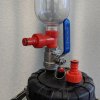- Joined
- Jun 13, 2017
- Messages
- 759
- Reaction score
- 1,135
- Points
- 93
So I have been using All-Rounders for almost a year now and brewing under pressure. One downfall so far is dry hopping, when i release pressure to hop the yeast/gunk blooms (for lack of better words) and I lose all the pressure.
I was thinking about using magnets to hold a small hop spider and just tip it over when the time is right.
How do you do it?
I was thinking about using magnets to hold a small hop spider and just tip it over when the time is right.
How do you do it?










